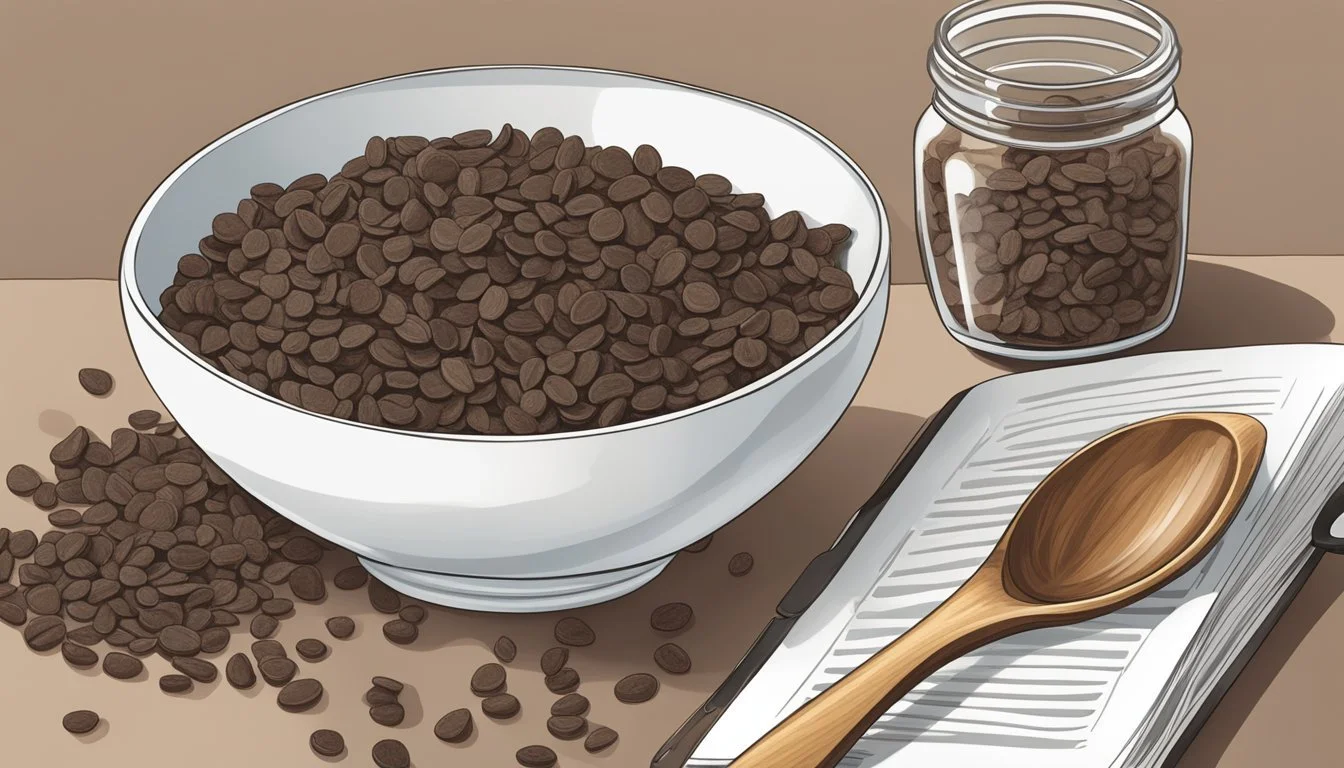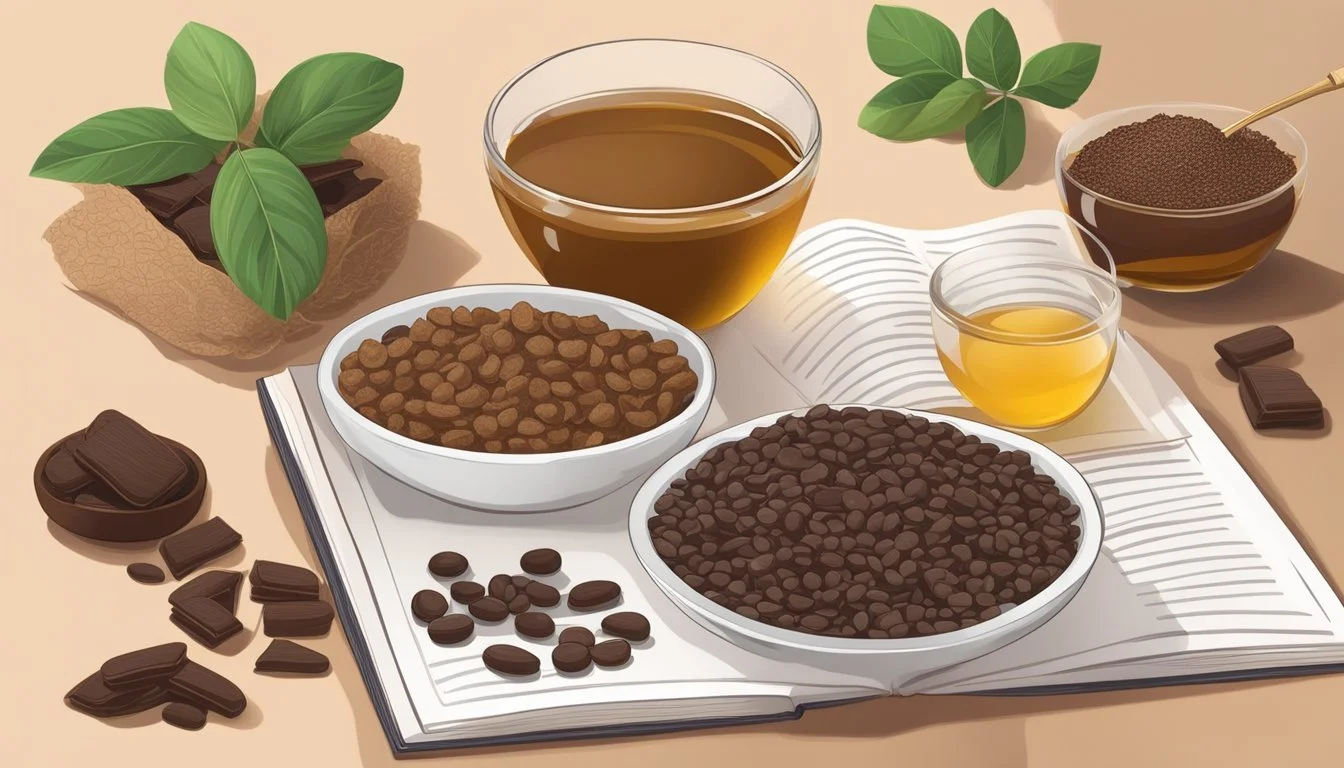Carob Chip Substitutes
Alternatives for Chocolate-Free Baking
When exploring alternatives to traditional chocolate (What wine goes well with chocolate?) chips, carob chips emerge as a popular substitute. They offer a naturally sweet flavor and are derived from the carob tree, presenting a different profile that appeals to those looking for variations in their baking and snacking. Carob chips can typically be used in a one-to-one ratio with chocolate chips, simplifying the substitution process for bakers at all levels of expertise.
The appeal of carob extends beyond its taste, as it also contains various nutrients and lacks some of the stimulants found in chocolate, such as caffeine and theobromine. This makes it a suitable option for those with dietary restrictions or sensitivities. Additionally, individuals looking to reduce their sugar intake may turn to carob chips, as they contain natural sugars and are often less processed compared to conventional chocolate chips.
Beyond carob, there are numerous other substitutes that can fill the role of chocolate chips in recipes. Nuts, for instance, add a crunchy texture and a hint of saltiness, which can enhance the overall flavor profile of baked goods and desserts (What wine goes well with desserts?). These substitutes not only cater to diverse dietary requirements but also encourage culinary creativity, offering bakers the opportunity to experiment with flavors and textures in their creations.
Understanding Carob
Carob is renowned for its natural sweetness and health benefits, making it a sought-after substitute for chocolate chips. The use of carob in cuisine extends from its pods, offering an array of nutritional values.
Origin of Carob
Carob has historical roots dating back to ancient civilizations in Greece, Italy, and the Middle East. It is derived from the carob tree (Ceratonia siliqua), which belongs to the pea family and is native to the Mediterranean region. The cultivation of this tree in the United States started in the 1800s.
Carob Tree and Pods
The carob tree blossoms with sturdy dark green leaves and produces long, leathery pods filled with an edible pulp. When these pods mature, their insides turn a chocolate-brown color, and they are often ground into carob powder. The pods can also be processed into carob chips, which are a common chocolate chip substitute in baking.
Nutritional Profile
Carob is not only appreciated for its flavor but also for its commendable nutritional content. Here's a breakdown of what carob contains:
Fiber: An excellent source of dietary fiber, carob can aid in digestion.
Vitamins & Minerals: Rich in calcium, potassium, and magnesium, and contains a variety of other minerals like copper, zinc, and manganese. It is also a source of vitamin A.
Antioxidants: Carob is packed with antioxidants, which help in fighting free radicals.
Nutrients Amount in Carob (approximate) Dietary Fiber 40-50% of pulp weight Calcium High Potassium High Magnesium Moderate Vitamin A Present Antioxidants High
The pods' edible pulp translates into carob powder and chips which inherit these nutrition facts, making them not just a confectionery delight but also a contributor to a well-rounded diet.
Carob Chips as a Chocolate Alternative
Carob chips offer a unique option for those seeking a substitute for chocolate chips due to dietary preferences or health considerations. This section will explore how carob chips stack up against traditional chocolate chips, their health advantages, and the sensory differences consumers might expect.
Comparison to Chocolate Chips
Carob chips and chocolate chips differ significantly in their composition. Carob chips are caffeine-free, making them a suitable option for individuals sensitive to stimulants. Unlike chocolate, carob needs no added caffeine to provide a rich taste, which is an inherent characteristic of the carob pod.
Chocolate chips: Typically contain cocoa solids, sugar, milkfat, and often added caffeine.
Carob chips: Derived from the dried, roasted, and ground pods of the carob tree, with a naturally sweet taste that usually requires less added sugar.
Health Benefits of Carob
Carob chips are not only a chocolate substitute but also provide several health benefits that distinguish them from their chocolate counterparts. They are low in fat and high in dietary fiber, assisting in digestive health. Furthermore, they are often touted to contain vitamins and minerals such as calcium and iron.
Low fat content: Carob chips are naturally lower in fat than chocolate chips.
High in dietary fiber: Helps to promote a healthy digestive system.
Vitamins and minerals: A source of essential nutrients like calcium and iron.
Taste and Texture Differences
Carob chips are less bitter than chocolate and have a naturally sweet flavor, which may reduce the need for additional sweeteners in recipes. In terms of texture, carob chips are firmer than chocolate chips and do not melt as easily, which can affect the texture of baked goods.
Flavor: Carob has a sweet, distinct taste, different from the rich bitterness of chocolate.
Melting point: Carob chips have a higher melting point, which changes how they behave when heated, impacting the texture of desserts.
Substitutes for Carob Chips
When seeking alternatives to carob chips, one has several options that provide unique flavors and textures suitable for various baking needs.
Baking with Cocoa Powder
Cocoa powder offers a rich chocolate flavor as a carob chip substitute. For every ounce of carob chips, one can use one tablespoon of cocoa powder mixed with a tablespoon of sugar and two tablespoons of fat, like butter or oil, to achieve a similar richness in cakes and cookies.
Using Cacao Nibs and Seeds
Cacao nibs are a more natural chocolate substitute, providing a crunchy texture with a bitter, complex chocolate flavor. They can be used in a one-to-one ratio for carob chips in most recipes. Seeds, such as sunflower or pumpkin seeds, can also contribute a nutty taste and an extra crunch, making them excellent for health-conscious recipes.
Incorporating Nuts and Dried Fruit
Nuts like almonds, cashews, and walnuts can replace carob chips to add a different dimension to baked goods. Alongside nuts, dried fruits such as raisins offer a natural sweetness and chewiness; they work well when chopped to the size of carob chips and added in equal measure.
Alternative Sweet Chips Options
For those desiring a diversity of flavors, several sweet chip alternatives exist:
Yogurt Chips: Creamy and sweet, they provide a distinctive taste and are especially good in baked recipes.
Peanut Butter Chips: Offer a creamy, rich peanut flavor that complements chocolate and vanilla-based desserts.
Butterscotch Chips: Provide a buttery and sweet taste, ideal for cookies and bars.
Caramel Chips: Impart a soft, melt-in-your-mouth texture with a deep caramelized sugar flavor.
Each of these alternatives brings a unique character to baked creations, allowing one to experiment beyond traditional carob chip flavors.
Carob in Cooking and Baking
In the culinary world, carob is lauded for its versatility and healthful attributes. It often serves as a substitute for cocoa or chocolate, offering a naturally sweet flavor and a host of benefits, notably its caffeine-free and low-fat profile.
Carob in Savory Dishes
When it comes to savory concoctions, carob's unique, sweet taste can complement dishes that benefit from a hint of sweetness. Chefs may incorporate carob powder into sauces or rubs to add a subtle, underlying note that pairs well with the richness of certain meats or the natural sweetness of roasted vegetables. Carob syrup, due to its sticky consistency and sweetness, is also an excellent glaze for various proteins or as a base in salad dressings, providing both flavor and a light texture.
Carob-Based Treats
The realm of sweets and baked goods is where carob truly shines as a chocolate substitute. In cookies and cakes, carob chips can replace both cocoa nibs and baking chocolate, offering a less intense but still gratifying chocolate-like flavor. For those seeking gluten-free options, carob chips in a mix with gluten-free flour yield delicious, soft, and chewy treats that are both satisfying and lighter on the stomach. Moreover, the naturally occurring sweetness of carob can reduce the need for added sugar in recipes, which is beneficial for those monitoring their sugar intake.
Using Carob Powder and Syrup
Carob powder can be used in nearly any recipe that calls for cocoa powder. This is especially helpful for individuals managing their fat consumption as carob powder contains significantly less fat than its cocoa counterpart. When baking, individuals may use carob powder to craft delectable goods like brownies or pancakes, giving them a refreshingly unique flavor. As for carob syrup, it's an excellent addition to beverages, providing a sweet and smooth consistency. Both the powder and syrup can also serve as enhancements in fruit-based dishes, contributing a depth of flavor that complements the natural tartness or sweetness of the fruit.
Carob's Role in Dietary Considerations
In addressing dietary restrictions and preferences, carob emerges as a versatile substitute offering vegan, allergy-friendly, gluten-free, and low-caffeine options. It’s important for consumers looking for alternatives to chocolate that are inclusive of various dietary needs.
Carob for Vegan and Allergy-Friendly Cooking
Carob chips act as an excellent alternative for those following a vegan diet or requiring dairy-free ingredients. Unlike chocolate, which often contains milk, carob is naturally free of animal-derived components, making it an ideal stand-in for traditional chocolate chips. Furthermore, for individuals allergic to peanuts, carob chips can be safely enjoyed as they do not contain peanut products and are less likely to be processed in facilities that handle peanuts, reducing the risk of cross-contamination.
Gluten-Free and Low-Caffeine Options
For people with gluten sensitivities, carob offers a gluten-free alternative to certain chocolate products that may contain gluten fillers. Carob naturally lacks gluten, which is a protein found in wheat, barley, and rye. Additionally, carob is free from theobromine, a stimulating compound found in the cacao bean. This makes carob a suitable option for those looking to avoid the caffeine-like effects associated with chocolate consumption, particularly beneficial for individuals who are sensitive to stimulants or who seek low-caffeine diets for personal health reasons.
Additional Uses of Carob
Carob, often used as a chocolate substitute, has applications that extend beyond culinary delights. It is not only a sweetener but also plays a role in health supplements and cosmetic products due to its nutritional profile and beneficial properties.
Carob as a Health Supplement
Carob is a nutritious supplement, appreciated for its dietary fiber and protein content. Brimming with essential nutrients such as calcium and magnesium, carob can support bone health and contribute to overall well-being.
Fiber: Aids in digestion and helps maintain a healthy gut.
Protein: Crucial for muscle repair and growth.
Calcium & Magnesium: Vital for strong bones and teeth, as well as nerve and muscle function.
The roasted carob pods, when ground into powder, can be added to medications and vitamins as a natural sweetener or binder. With no caffeine, it offers a suitable option for those who are caffeine-sensitive.
Carob in Cosmetic Products
In the realm of skin care, carob is employed for its hydrating and soothing properties. Its extracts mitigate the need for harsh chemicals in products, allowing for more natural formulations.
Skin Care: As an additive, carob extract hydrates and improves skin health.
Binder: It also acts as a binder in cosmetics, contributing to the texture and consistency of products.
This natural ingredient, rich in vitamins and antioxidants, provides an alternative to synthetic additives and promotes a gentle approach to beauty regimes.
Carob and Its Environmental Impact
Carob trees, scientifically known as Ceratonia siliqua, offer sustainable agricultural benefits due to their hardy nature and low environmental impact. This section explores the environmental benefits of carob tree cultivation and its agricultural role.
Sustainable Cultivation of Carob Tree
Carob trees flourish in arid and semi-arid regions of the Mediterranean. They are renowned for their drought resistance and salinity tolerance, which make them well-suited for sustainable cultivation. The deep root systems of the carob tree are advantageous for carbon sequestration, as they absorb and store CO2 from the atmosphere, thereby contributing to the mitigation of global warming. This aspect of carob cultivation strengthens its position as a sustainable crop, requiring minimal intervention to grow effectively.
Key Sustainable Features of the Carob Tree:
Drought resistance: Enables growth in water-scarce environments.
Salinity tolerance: Suitable for cultivation in a variety of soils.
Carbon sequestration: Deep roots help in mitigating climate change effects.
Carob's Position in Agriculture
In the context of agriculture, the carob tree is notable for its contribution to sustainable practices. Traditionally, carob pods, the fruit of the Ceratonia siliqua tree, also known as locust beans, were mainly utilized as animal feed. However, their utility has expanded due to carob's potential health benefits and as a cocoa substitute in the production of carob chips.
Agricultural Role of Carob:
Animal feed: An established use, with the potential for further development.
Cocoa substitute: Carob chips and powder serve as low-sugar, sweet alternatives for those seeking healthier options.
The carob tree's minimal need for pesticides and fertilizers, coupled with its resilience, supports a more environmentally friendly form of agriculture, enhancing soil conditions and biodiversity. These characteristics contribute meaningfully to the agricultural system, particularly within sustainable models.
Purchasing and Storing Carob Products
When selecting carob products as a substitute for chocolate bars, including white chocolate and unsweetened baker's chocolate, consumers should focus on quality and proper storage. Carob offers a unique, earthy flavor with a nutty hint and is a favorite in creating healthier sweet treats due to its lower cholesterol impact, although it’s important to note scientific evidence is needed to fully confirm health benefits. Here's how to find and store carob for optimal freshness and flavor.
Finding Carob in Grocery Stores
Carob can typically be found in health food stores or well-stocked grocery stores. Look for carob powder or chips with a rich, brown hue, which suggests minimal processing. Quality carob products should come in well-sealed packaging to prevent moisture infiltration, which can compromise the product's integrity. For those looking to avoid added sugars, ensure to check if the carob chips are sweetened with natural alternatives like stevia or barley malt.
Health Food Store: Rich brown carob powder, carob chips, carob gum
Grocery Store: Sweetened and unsweetened carob products, sometimes located near hot chocolate mixes
Shelf Life and Storage Tips
To maximize the shelf life of carob products, store them in a dry, cool, and airtight container. An ideal location is a cool, dry pantry away from direct sunlight and heat sources to prevent degradation of flavor and texture. Properly stored, carob can last up to two years depending on the form—powder or chips—and initial quality. Avoid storing near strong-smelling foods as carob may absorb odors.
Cool and Dry: Essential to prevent clumping and spoilage
Airtight Container: Preserves flavor and freshness
Away from Sun and Heat: Prolongs shelf life
Odor-Free Area: Prevents flavor contamination
Conclusion
When seeking alternatives to traditional chocolate chips, carob chips emerge as a standout substitute. They carry a similar texture and are an appealing option for those with dietary restrictions or simply pursuing variety in flavor. Carob itself imparts a sweet and nutty taste that includes undertones of caramel and coffee, distinguishing it from its chocolate counterpart.
Nutritional Value: An advantage of carob chips lies in their nutritional benefits. They do not contain caffeine and are lower in fat and calories than chocolate, making them a favorable choice for those monitoring their dietary intake. Furthermore, carob is rich in fiber and antioxidants, contributing to its healthful profile.
Usage in Recipes: Carob chips can be used in a one-to-one ratio for chocolate chips in most recipes, providing a seamless transition for bakers. Additionally, incorporating carob powder can enhance the flavor while maintaining a dessert's desired consistency.
For those unable to consume carob, there is a variety of other substitutes to consider:
Cocoa Powder: Mixed with sugar and butter, this becomes a creamy alternative that mimics chocolate's rich taste.
Nuts and Dried Fruits: Offer texture and nutritional benefits.
White Chocolate: Caters to different taste preferences and dietary needs.
Bakers have numerous options to explore when replacing chocolate chips, each delivering distinct flavors and nutritional profiles. The choice of substitute can transform traditional treats into new sensory experiences while aligning with individual health considerations.






